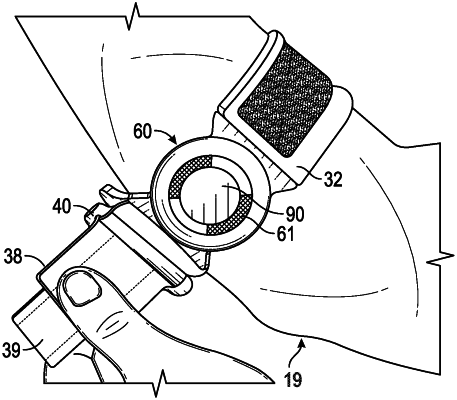| CPC A61F 5/013 (2013.01) [A61F 5/32 (2013.01)] | 9 Claims |

|
1. An epicondylitis brace assembly for providing therapy to either a medial epicondyle or a lateral epicondyle of an elbow of a person, the person further having a humerus, extensor tendons, an extensor carpi radialis brevis (ECRB), an olecranon, forearm muscles in a forearm, and an ulna, the epicondylitis brace assembly comprising:
a flexible band having a first end and a second end, and a width W between two opposing side edges;
a D-ring fixed with the first end of the flexible band and adapted to receive the second end therethrough, the flexible band having a two-part mechanical fastener having a first-part thereof fixed proximate the first end of the flexible band, and a second part of the two-part mechanical fastener being fixed with the flexible band adjacent the first part of the two-part mechanical fastener;
a toric ring fixed with the flexible band proximate the D-ring, the D-ring being disposed between the toric ring and the first end of the flexible band;
wherein the toric ring includes an open mesh having two opposing ends, a central ring fixed with each of the two opposing ends and having a central area, a central nodule fixed within the central area and with the open mesh, the central nodule comprising a top side with a permanently concave actuator and a bottom side with a complex convex surface, the open mesh being located between the permanently concave actuator and the complex convex surface of the central nodule;
whereby with the epicondylitis brace assembly fixed about the person's elbow wherein the complex convex surface contacts either the person's medial epicondyle or the person's lateral epicondyle, pressure is applied to either the medial epicondyle or a lateral epicondyle by a force of the open mesh, and additional pressure applied to the permanently concave actuator serves to cause the complex convex surface to apply pressure to either the medial epicondyle or the lateral epicondyle;
whereby when the person dons the epicondylitis brace assembly with the toric ring fixed at either the medial epicondyle or the lateral epicondyle, pressure is applied to either the medial epicondyle or the lateral epicondyle.
|